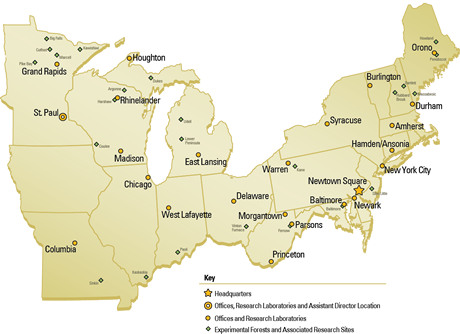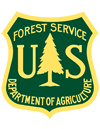
Research Highlights
Northern Research Station
Forest Disturbance Processes
Disturbances to the forest ecosystem structure can be caused by phenomena such as fire, extreme weather (drought, wind, and ice storms),deer overpopulation, and invasive non-native pest species (fungal diseases, insects, and weedy plants), as well as by anthropogenic factors such as global climate change, logging, development, and arson. These can damage or destroy trees and understory plants and change the species distribution and health of plants and animal populations in the forest. Disturbances can have negative or positive effects on the sustainability of various ecosystems, according to the long-term management goals of the land.
Defining Light Levels and Light Quality that Minimize Invasive Plant Growth but Promote Oak Growth
Oaks may have an advantage over invasive plants at right ideal light levels and light quality
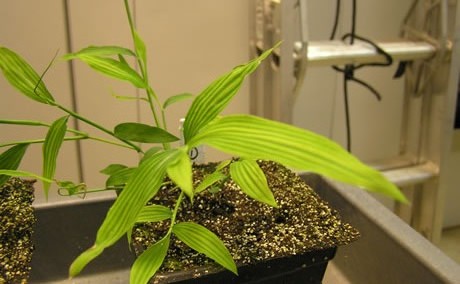
Defining Light Levels and Light Quality that Minimize Invasive Plant Growth but Promote Oak Growth
Oaks may have an advantage over invasive plants at right ideal light levels and light quality
Oak regeneration in eastern forests is dependent on an increase in light to the understory, which is accomplished by harvesting or fire. Unfortunately, these disturbances also promote invasive growth of the nonnatives tree-of-heaven, garlic mustard, and Japanese stiltgrass. Forest Service scientists grew these three invasive species and northern red oak in growth chambers under eight light levels and corresponding light quality, which represented forest light conditions under different management regimes. All three invasive plants showed significantly less shoot growth at lower light levels, roughly equivalent to a forest that had been burned, thinned, or harvested as a light shelterwood (that is, light levels below 180 micromoles/m2/sec and a ratio of red to far red light [R:FR] equal to 0.64). Although adequate oak growth in the field has been achieved at low light levels, the data revealed no patterns in oak shoot growth, possibly due to seed-source effects or root limitations. At low light levels, Japanese stiltgrass exhibited physical signs of stress; its shoot growth levels were lowest and water stress highest. Forest management resulting in low light levels combined with lower light quality may deter growth of invasive plant species.
- Contact:
- Year: 2013
Surge in red spruce growth following decades of acid deposition-related decline.
Surge could signal a reversal in pollution-related damage due to improved air quality

Surge in red spruce growth following decades of acid deposition-related decline.
Surge could signal a reversal in pollution-related damage due to improved air quality
Inputs of acid deposition are firmly linked to changes in tree nutrition, reductions in woody growth, and increases in mortality for numerous tree species. In red spruce, broad-scale mortality occurred during the peak of pollution emissions. Acid deposition alters the nutrition of red spruce trees, making them vulnerable to foliar winter injury and loss, and often leading to growth reductions and tree death. Declines in growth also affect the capacity of forests to capture carbon dioxide from the air. Research by a Forest Service scientist and partners documented that a regional 2003 winter injury event reduced the growth of red spruce trees for at least 3 years and estimated that cumulative reductions across the landscape were large. However, researchers were surprised to find that, after growth reduction from the 2003 winter injury, red spruce in New England experienced a dramatic growth increase to levels almost twice the average growth for the last 100 years. New research is examining if recent reductions in air pollution or climate change (warmer winters that reduce foliar injury and extend the growing season) can help account for this remarkable rebound.
- Contact:
- Products & Resources:
- Partners:
- Year: 2013
Data Show Need for Prompt Removal of Dead Ashes
Safety hazards develop quickly from ash trees killed by emerald ash borer

Data Show Need for Prompt Removal of Dead Ashes
Safety hazards develop quickly from ash trees killed by emerald ash borer
Yearly data collected by Forest Service scientists on thousands of ash trees in emerald ash borer (EAB)-infested sites in Ohio help managers planning their response to EAB in their forests. The dataset, begun in 2005, tracks each individual tree over time to show declining canopy health, EAB symptoms, death, and tree fall. Over 80% of dead ash trees fell within 5 years of dying, with some of them falling much sooner. Recently, this information was used in a plan to remove dying ash trees along trails in an Ohio Department of Natural Resources Nature Preserve to prevent these hazardous trees from falling on people.
- Contact:
- Products & Resources:
- Partners:
- Year: 2013
Role of social factors in wildfire outcomes
Systematic post-fire collection of data on social dynamics during fires improves positive community outcomes

Role of social factors in wildfire outcomes
Systematic post-fire collection of data on social dynamics during fires improves positive community outcomes
To better understand the role of social dynamics before and during a wildfire event in determining outcomes, Forest Service scientists and cooperators are developing a research framework that can be used by researchers and managers to systematically gather information immediately after an event on key social dynamics during and before the fire. This process can help clarify how local context and interactions between diverse factors—from fire management decisions, to homeowner decisions, to communication processes—contribute to positive and negative wildfire outcomes. The consistent methodology developed can be used across multiple fires to improve the ability to learn across events. Over time, this will allow for identification of ways to improve both fire programs and social fire outcomes. The protocol has been refined over the course of two fires in 2012 and two in 2013. Initial findings across fires have identified the importance of pre-fire training amongst emergency responders in fostering relationships that facilitate effective interactions during an event and of open and honest communication with the public not only about what is most directly relevant to them, but also the specific mechanics of fighting a fire.
- Contact:
- Products & Resources:
- Partners:
- Year: 2013
Urban Natural Resource Stewardship
More than 80% of the U.S. population lives in urban and suburban areas. The urban forests---street and park trees as well as landscape plantings on private lands---provide important ecosystem services to urban residents and workers. A healthy urban forest can help reduce air pollution and urban core temperatures and thus make cities more livable. Mitigation of past declines of urban forests and open space; maintenance of the health of street trees and open spaces; revitalization of neighborhoods and righting of past environmental injustices are important issues for urban forest managers.
Urban Trees Save Lives
By removing airborne fine particulate matter, urban trees improve human health
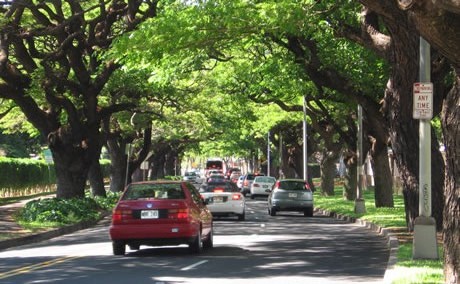
Urban Trees Save Lives
By removing airborne fine particulate matter, urban trees improve human health
Urban air pollution is a serious human health issue. Trees can remove fine particles from the atmosphere and consequently improve air quality and human health. A Forest Service scientist modeled the effects of urban trees on fine particulate matter concentrations and human health for 10 U.S. cities. He found that the total amount of these particles removed annually by trees varied from 4.7 metric tons in Syracuse to 64.5 metric tons in Atlanta, with resulting annual values varying from $1.1 million in Syracuse to $60.1 million in New York City, mostly from the effects of reduced human mortality. Mortality reductions were typically around 1 person per year per city but were as high as 7.6 people per year in New York City. Average annual percent improvement of air quality ranged between 0.05% (San Francisco) and 0.24% (Atlanta). Understanding the impact of urban trees on air quality can lead to improved urban forest management strategies to sustain human health in cities.
- Contact:
- Partners:
- Year: 2013
Understanding and Supporting the Transition from Job Training to Green Jobs
Grads show positive environmental attitudes and behaviors and increased self-confidence after New York City program
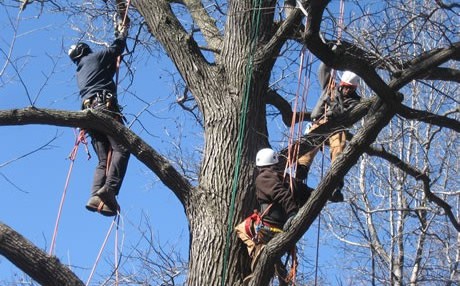
Understanding and Supporting the Transition from Job Training to Green Jobs
Grads show positive environmental attitudes and behaviors and increased self-confidence after New York City program
In 2009, the Forest Service’s Northern Research Station and Northeastern Area State and Private Forestry partnered in supporting the MillionTreesNYC Training Program, with $2 million to help fund the employment of graduates from the 9-month training program. The training program, run by the New York City Department of Parks and Recreation and New York Restoration Project, targeted 18- to 24-year-olds who were previously disconnected from the workforce. Graduates of the program worked directly in arboriculture, ecological restoration, landscape design, and horticulture. Subsequently, Forest Service scientists convened a workshop on how to improve the transition from green-job training to careers. They reported on lessons learned by experts, practitioners, and trainers, who participated in a panel discussion, followed by roundtable discussions, and a keynote address. They also analyzed the experiences of graduates from the program and found that these urban conservation jobs could be transformational for economically disadvantaged youth.
- Contact:
- Products & Resources:
- Partners:
- Year: 2013
Urban Waters Partnership for Northwest Indiana: A Unique Collaboration
Federal and local partners work to improve local water quality and people’s access to the great (and wet) outdoors

Urban Waters Partnership for Northwest Indiana: A Unique Collaboration
Federal and local partners work to improve local water quality and people’s access to the great (and wet) outdoors
The Northwest Indiana Urban Waters Partnership focuses on waterways with wide-ranging regional impacts. With leadership from Forest Service scientists, the federal partnership is working with local organizations concerned about waterways such as the Grand Calumet River Area of Concern, the East Branch of the Little Calumet River, Salt Creek, Trail Creek, and Deep River, and of course, Lake Michigan. Early partnership successes include 1) progress on an environmental assessment necessary to expand paddling opportunities at Indiana Dunes National Lakeshore; 2) Army Corps of Engineers modification of a dam along Deep River to facilitate paddling; 3) development of an online mapping tool (by the US Geological Survey) to allow local users to upload and map different regional information; 4) Forest Service grants awarded to three local communities to address water-quality risks caused by the loss of ash trees to the emerald ash borer; 5) restoration of 38 acres of river and upland ecosystems near Chesterton by the Army Corps of Engineers and the Shirley Heinze Land Trust; 6) exploring options for remediating water quality at East Chicago’s Jeorse Park Beach, one of the most polluted beaches in the country; and 7) providing canoe adventures for children through Wilderness Inquiry visits.
- Contact:
- Products & Resources:
- Partners:
- Save the Dunes; the Cities of Gary, Hobart, Michigan City, and Valparaiso; the Northwest Indiana Paddling Association; the Steelheaders; the Counties of LaPorte, Porter, and Lake; Coffee Creek; and the Indiana Departments of Natural Resources and Environmental Management.
- United States Departments of Agriculture, Education, Energy, Housing and Urban Development, the Interior, & Transportation; Army Corps of Engineers; Centers for Disease Control and Prevention; Environmental Protection Agency; National Institute of Environmental Health Sciences; National and Community Service; National Oceanic and Atmospheric Administration; US Economic Development Administration
- Year: 2013
Conserving Biodiversity in Urban Landscapes
Working with citizen scientists to develop guidelines for conserving biodiversity in urban areas

Conserving Biodiversity in Urban Landscapes
Working with citizen scientists to develop guidelines for conserving biodiversity in urban areas
Loss of biodiversity as a result of residential development is a national and global issue and conservation of biodiversity in urban areas is important to keeping cities livable. Forest Service scientists developed habitat relationship models to calculate the bird habitat potential of the urban forest by linking habitat relationship models with the U.S. Forest Service urban forest assessment tool, i-Tree. As part of that effort, researchers are investigating songbirds and native pollinators in yards and urban forests to understand the conditions under which they can persist and flourish in urban landscapes. Citizen “scientists” monitor the fates of color-banded birds and nests in their yards to help understand the features of yards that support viable populations. Other homeowners are participating in a project that highlights the value of delayed lawn mowing to support native pollinators and other beneficial insects. Finally, scientists are monitoring the abundance and nesting success of songbirds in forest patches and comparing these values to extensively forested areas. Using this information, we can provide homeowners and municipalities with information to guide their practices and policies to promote biodiversity from the scale of individual yards to forest conservation areas.
- Contact:
- Products & Resources:
- Partners:
- Susannah Lerman
- David Bloniarz
- Keith Nislow
- Peter Marra, Smithsonian Institute; Alexandra Contosta, University of New Hampshire; Christofer Bang, Arizona State University; Scott Schlossberg, Stephen DeStefano, Joan Milam, & Paige Warren, University of Massachusetts, Amherst; & Mitch Hartley, US Fish and Wildlife Service, WHERE?
- Year: 2013
Sustaining Forests
The Northeastern and Midwestern forests are the defining elements of much of the natural environment in their region. This region is the most heavily forested region of the United States, and 76 percent of the forested lands are privately owned, mostly by non-industrial, family landowners. Sustaining this mix of privately owned and public forests involves understanding their ecology (at scales ranging from individual organisms to broad landscapes); their relationships to people and communities; and developing appropriate management strategies in the face of changing environmental conditions (climate) and of changing social conditions (economics and demographics).
Tree-species range shifts in a changing climate: should we assist in the process?
Assisting with natural process may help maintain species

Tree-species range shifts in a changing climate: should we assist in the process?
Assisting with natural process may help maintain species
Foresters and ecologists are becoming increasingly concerned about the ability of tree species to “migrate” (via seed dispersal and varying seedling growth) in response to changes in climate zones resulting from global climate change. Evidence from pollen records estimate historical rates of movement by trees at about 30 miles per century. When the impacts of humans are added, like the creation of migration barriers with extensive agriculture, the rate of natural migration is slowed even further so that it now is much slower than the rate of climate change. The Forest Service scientists who developed the Climate Change Bird and Tree Atlases have studied the effects of a modeled “forestry or ecosystem assisted migration,” in which trees would be planted in climatically suitable locations outside (usually to the north) of current ranges to counter the effects of warming temperatures on survival and growth. They modeled the effect of “planting” (via computer) several stands of black oak and found that the rate of migration was hastened into its new suitable habitat in Wisconsin.
- Contact:
- Products & Resources:
- Partners:
- Donald McKenzie
- John Pedlar & Dan McKenney, Canadian Forest Service, Sault Ste. Marie, ON
- Year: 2013
Synthesis of the Fire-Oak Literature
Review clarifies best use of prescribed fire to regenerate mixed-oak forests
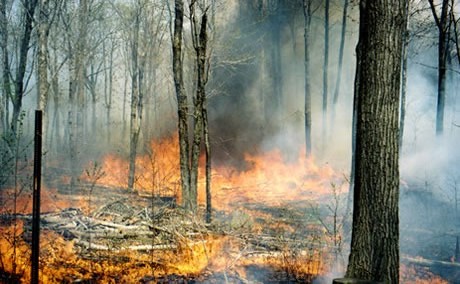
Synthesis of the Fire-Oak Literature
Review clarifies best use of prescribed fire to regenerate mixed-oak forests
The fire-oak hypothesis asserts that the current lack of wildland fire is behind the widespread difficulties in regenerating oaks (Quercus spp.) in eastern North America and that use of prescribed fire can help solve this problem. Forest Service scientists ran a meta-analysis of 52 papers from 32 prescribed fire studies conducted in mixed-oak forests to test the latter assertion. Overall, the results suggested that prescribed fire can contribute to sustaining oak forests in some situations. They identified several factors key to its successful use. Prescribed fire reduced midstory stem density, although this reduction was concentrated in the smaller-diameter stems. Prescribed fire preferentially selected for oak reproduction and against mesophytic hardwood reproduction, but this difference did not translate to an increase in the relative abundance of oak in the advance regeneration pool. Fire equalized the height growth rates of the two species groups. Establishment of new oak seedlings tended to be greater in burned areas than in unburned areas. Generally, prescribed burning provided the most benefit to oak reproduction when the fires occurred during the growing season and several years after a substantial reduction in overstory density. Single fires conducted in closed-canopy stands had little impact in the short term, but multiple burns eventually benefitted oaks in the long term, especially when followed by a canopy disturbance.
- Contact:
- Products & Resources:
- Partners:
- Year: 2013
Aerial transport of spruce budworm moths
Using meteorology and insect flight biology to simulate dispersal

Aerial transport of spruce budworm moths
Using meteorology and insect flight biology to simulate dispersal
Many economically important insect pest species rely on wind to disperse over great distances. Dispersal patterns traditionally have been difficult to measure, in part because the flight biology and behavior of insects is not well understood. The spruce budworm, a destructive defoliator native to North American boreal forests, however, has been well studied and adult budworms (moths) are known to disperse hundreds of kilometers using air currents. Forest Service scientists worked with partners to integrate the data into a budworm flight behavior model that, when coupled with output from a high-resolution atmospheric model, can produce detailed flight trajectories and deposition patterns over large landscapes. The model was tested on a small outbreak in northern Minnesota in June 2007, and resulting flight deposition patterns were consistent with budworm moth collections performed over the same time period. This modeling approach may be applied to a wide array of important forest and agricultural pest species to understand the spatial dynamics of outbreaks, and potentially forecast risk of damage and model the spread of invasive insects.
- Contact:
- Products & Resources:
- Partners:
- Year: 2013
Reducing Deforestation and Forest Degradation
Promoting Sustainable Landscapes in the United States and Mexico
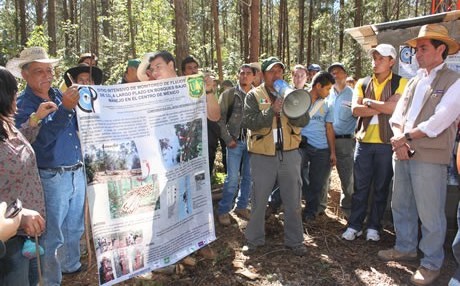
Reducing Deforestation and Forest Degradation
Promoting Sustainable Landscapes in the United States and Mexico
Research on landscape-scale forest monitoring has been sponsored by U.S. government agencies for 10 years as part of the North American Carbon Program and since 2011 by the U.S. Agency for International Development and the U.S. Forest Service under the “Sustainable Landscapes” program. Intensive monitoring sites were established at seven experimental forests in the U.S. and three demonstration sites in Mexico. Research towers loaded with monitoring equipment reach from the forest floor to a height of 15 meters above the tops of the trees, and a network of field measurement sites is scattered over 9 km2 of the surrounding landscape. These sites are used for research and teaching, developing forest management practices, and forging links to the needs of communities. The sites support the information requirements for implementing programs such as Reducing Emissions from Deforestation and Forest Degradation (REDD+), a program that enables communities in developing countries to receive payments for ecosystem services such as reduced carbon emissions or improved forest management. In addition to providing benchmark data for REDD+ projects at the community scale, the sites are valuable for validating state and national estimates from satellite remote sensing and the national forest inventory.
- Contact:
- Products & Resources:
- Defining a landscape-scale monitoring tier for the North American Carbon Program. Chapter 1
- Database for landscape-scale carbon monitoring sites
- Approaches to monitoring changes in carbon stocks for REDD+
- Tercer Taller de Medición de Carbono Forestal: Intercambio de Experiencias Internacionales sobre Protocolos de Monitoreo, Reporte y Verificación de Carbono Forestal
- Partners:
- John Bradford, Kenneth Clark, Jason Cole, Robert Evans, Rafael Flores, Michael Gavazzi, David Hollinger, John Hom, Coeli Hoover, Kristofer Johnson, Randy Kolka, Kevin McCullough, Steve McNulty, Alicia Peduzzi, Yude Pan, Michael Ryan, Kristen Schmitt, Nicholas Skowronski, Craig Wayson, Peter Weishampel, & Alexandra Zamecnik
- NASA, U.S. Agency for International Development, The Nature Conservancy, Mexican Forest Service, Colegio de Postgraduados, Centro de Investigacion Cientifica de Yucatan, El Colegio de la Frontera Sur, Fondo Mexicano para la Conservación de la Naturaleza, the Mexico-Norway program, University of New Hampshire
- Year: 2013
Providing Clean Air and Water
Northeastern and Midwestern forests are vital for providing abundant clean water and air for the regions' many rural and urban inhabitants. For example, water that has passed through forests is cleaner than water than that has drained from roads or disturbed lands. By taking up carbon dioxide for use in photosynthesis, trees help reduce greenhouse gases and improve the local and global environment. Forests also receive harmful atmospheric pollutants such as acid precipitation and mercury, which alter the soil and harm tree health and alter lake ecosystems.
Seed Orchards Help Battle Beech Bark Disease
Regional beech seed orchards to provide seedlings to state and national forests for restoration plantings

Seed Orchards Help Battle Beech Bark Disease
Regional beech seed orchards to provide seedlings to state and national forests for restoration plantings
Forest Service researchers and colleagues have developed a test for identifying American beech trees resistant to the invasive beech scale insect responsible for initiating beech bark disease and are training personnel from state and national forests to use it. Once resistant trees are identified, dormant branches are grafted onto seedlings and these grafted clones are being planted in seed orchards. Genetic studies of resistant parent trees destined for one orchard have shown that about half of the seedlings produced will inherit resistance to beech bark disease. The seeds produced will be made available to state and national forests to grow seedlings for use in planting healthy American beech trees in areas where beech bark disease is prevalent. Personnel at the Eastern Region’s Oconto River Seed Orchard (ORSO) in White Lake, WI, have recently joined the battle against beech bark disease by assisting with grafting efforts. Currently, three regional seed orchards are being installed thanks to funding support from Northeastern Area State and Private Forestry and the collaborative efforts of FS Research, ORSO, the Allegheny, Monongahela, and Hiawatha National Forests, the Holden Arboretum in Kirtland, OH, and the states of Michigan, Pennsylvania, and West Virginia.
- Contact:
- Products & Resources:
- Partners:
- Eastern Region (R9): Allegheny National Forest, Monongahela National Forest, and Hiawatha National Forest
- State and Private Forestry, Oconto River Seed Orchard, Forest Health Monitoring, & Forest Health Technology Enterprise Team for Special Technology Development
- Michigan Department of Natural Resources
- Pennsylvania Department of Conservation & Natural Resources
- Year: 2013
Trees Using Water More Efficiently as Atmospheric Carbon Dioxide Rises
Rising atmospheric carbon dioxide levels show direct and unexpectedly strong influence on ecosystem

Trees Using Water More Efficiently as Atmospheric Carbon Dioxide Rises
Rising atmospheric carbon dioxide levels show direct and unexpectedly strong influence on ecosystem
Forest Service scientists working with Harvard University and other partners analyzed direct, long-term measurements of whole-ecosystem carbon and water exchange and found a substantial increase in water-use efficiency in temperate and boreal forests of the Northern Hemisphere over the past two decades. This increase has implications for ecosystem function, services, and feedbacks to the climate system, including enhanced timber yields and improved water availability, which could partially offset the effects of future droughts. Their results suggest that increases in carbon dioxide are already changing the way forests function. Data came from seven sites in the midwestern and northeastern United States that are part of the AmeriFlux Network, including the Forest Service’s Bartlett Experimental Forest in New Hampshire and the Howland Cooperating Experimental Forest in Maine. Additional data from 14 other Northern Hemisphere sites confirmed the trends.
- Contact:
- Products & Resources:
- Partners:
- Year: 2013
Supporting research and international training through the International Soil Carbon Network
Advancing belowground carbon understanding, monitoring, and reporting

Supporting research and international training through the International Soil Carbon Network
Advancing belowground carbon understanding, monitoring, and reporting
Soils are the great unknown in understanding the global carbon cycle because the amounts, cycling, and effects of management on soil carbon are often difficult to measure or understand. The International Soil Carbon Network (ISCN) database, a research tool developed by Forest Service scientists with the help of many partners, facilitated several synthesis projects, including one that assessed the effects of afforestation on soil carbon in the continental United States. The ISCN also works internationally, having expanded from the former National Soil Carbon Network in response to interest among the international scientific community, and several highlights in FY2013 stem from this international growth. The ISCN added three more renowned scientists from different countries to its steering group (bringing the total to 21), worked with international efforts to expand global data coverage, and facilitated a training workshop for agency and academic scientists from Colombia, Ecuador, Honduras, Mexico, and Peru. The workshop focused on measuring and reporting belowground carbon stocks.
- Contact:
- Products & Resources:
- Partners:
- Luke Nave, University of Michigan
- FS International Programs; National Forest Systems National Soils Program; Hiawatha National Forest
- US Agency for International Development; USDA Natural Resources Conservation Service, Agricultural Research Service, & National Institute of Food and Agriculture; USDI Geological Survey; U.S. Environmental Protection Agency; and the U.S. Department of Energy.
- Microsoft Research and the National Council for Air and Stream Improvement.
- Year: 2013
Scaling Up Aspen-FACE Experiment Results to Century and Landscape Scales
How elevated carbon dioxide and ozone will affect future tree species composition in northern forests

Scaling Up Aspen-FACE Experiment Results to Century and Landscape Scales
How elevated carbon dioxide and ozone will affect future tree species composition in northern forests
The Forest Service’s Aspen-FACE Experiment generated 11 years of data on the effects of elevated carbon dioxide (CO2) and ozone on the growth of field-grown trees (maple, birch, and six aspen clones) in northern Wisconsin. It is not known how these short-term plot-level responses might play out at the landscape scale over multiple decades. The scientists used a forest landscape model (LANDIS-II) to scale these site level results to broader temporal and spatial scales and several general principles emerged: 1) The productivity of a species under future conditions is the primary determinant of short-term dominance; 2) Longer term, longevity and shade tolerance may supersede productivity as the determinant of importance, depending on the disturbance regime; 3) Changes in the abundance of species were mostly gradual and none of the species disappeared from the landscape, even under treatments for which they were poorly adapted; 4) Different species fared relatively well under different treatments; 5) Accounting for spatial processes is important because seed dispersal and establishment may limit the ability of some species to colonize available habitat. Thus, there will be species “winners and losers,” but managers may have considerable control over outcomes by managing disturbance and landscape spatial pattern.
- Contact:
- Products & Resources:
- Partners:
- Year: 2013
Natural Resources Inventory, Monitoring, and Assessment
Ensuring the health and sustainabilityof the nation's forests requires scientifically credible and timely information about the extent, location, health, and ownership of these forests and the possible effects of global climate change. Forest managers and policy makers need detailed data to assess sustainability, to make important business decisions, to evaluate wildlife habitat, and for many other things. The Northern Research Station's Forest Inventory and Analysis (FIA) team is an important part of the national FIA network, which provides information on northeastern, midwestern, and Great Plains forests.
What Lies Beneath Bog Lake Fen
Evaluating changes to carbon levels with trace gas measurements

What Lies Beneath Bog Lake Fen
Evaluating changes to carbon levels with trace gas measurements
Peatlands accumulate carbon because of waterlogged, low-oxygen (anoxic) conditions that favor plant production over decomposition. With climate change, these carbon-rich systems could become lesser sinks for carbon or even potentially sources of carbon that would further exacerbate climate change. Anoxic conditions also allow for the formation of methane (CH4), a greenhouse gas that has 25 times (on a 100-year time horizon) the global warming potential of carbon dioxide (CO2 ). We directly measured gas exchange between peatland and atmosphere year-round using the eddy covariance technique, which is continuous, fast-response, large-scale, and noninvasive. Ongoing monitoring of CO2 exchange (beginning June 2006) and CH4 emissions (beginning April 2009) have captured dramatic changes in carbon balance. In summer 2011, record high temperatures plus a high water table caused extended warming (2+ meters deep) in the peat column, resulting in CH4 emissions 2.5 times greater than other study years. Summer 2011 also recorded the longest period of net uptake of CO2. Climate changes to spring/autumn seasons and precipitation patterns have also altered carbon production and decomposition. The annual carbon budget for Bog Lake Fen in Wisconsin, where measurements overlap, showed CH4 contributed significantly (23 to 39%) and based on the global warming potential of each gas, CH4 easily offsets the CO2 sequestration.
- Contact:
- Products & Resources:
- Partners:
- Year: 2013
Linking Land Use to Great Lakes water quality
Research helps prioritize investment of restoration dollars by predicting which watersheds will contribute to impaired water quality
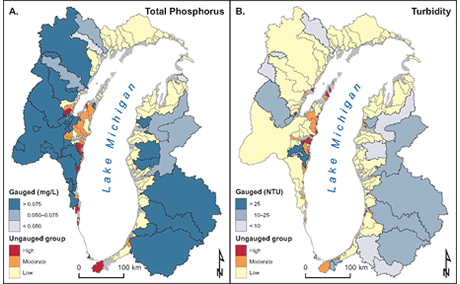
Linking Land Use to Great Lakes water quality
Research helps prioritize investment of restoration dollars by predicting which watersheds will contribute to impaired water quality
Watersheds have an important influence on water quality and watershed characteristics can be used to predict stream water quality. Forest Service scientists used novel information---derived from the Landsat data archive describing forest canopy cover change, along with forest inventory data and existing land cover data---to predict total phosphorus and turbidity in Great Lakes streams draining into Lakes Superior and Michigan. In the Lake Superior basins, phosphorus output increased with the amount of land used for agriculture, recent forest disturbance, and persisting forest cover; turbidity measurements increased with recent forest disturbance, the amount of land in agriculture, persisting forest, and urban land. In the basins draining into Lake Michigan, phosphorus output was related to ecoregion, increased with urban land, and decreased with older forest disturbance and watershed storage; turbidity measurements increased in some ecoregions and with recent forest disturbance, and decreased as the amount of conifer forest increased. Forest Service scientists used these relationships to identify and prioritize restoration areas in watersheds without observed in-stream data. This prioritization of watersheds will aid effective management of the Great Lakes Watershed and result in efficient use of restoration funds, leading to improved near-shore water quality.
- Contact:
- Products & Resources:
- Partners:
- Year: 2013
National Maps of Forest Carbon Stocks from FIA Data
Raster maps facilitate regional analysis and reporting

National Maps of Forest Carbon Stocks from FIA Data
Raster maps facilitate regional analysis and reporting
The United States has been providing national-scale estimates of forest carbon stocks and stock change to meet the reporting requirements of the United Nations Framework Convention on Climate Change. Although these currently are provided as national estimates by carbon pool and by year to meet greenhouse gas monitoring requirements, there is growing need to separate these estimates into finer scales so that strategic forest management and monitoring activities can be focused on various ecosystem services such as carbon storage enhancement. Through application of a nearest-neighbor imputation approach, spatially extant estimates of forest carbon density were developed for the conterminous U.S. by Forest Service scientists using FIA annual forest inventory data. Comparisons among imputed maps indicate strong regional differences across carbon pools. The carbon density of pools related to detritus input is often highest in forests suffering from recent mortality events such as those in the northern Rocky Mountains. In contrast, live-tree carbon density is often highest on the highest quality forest sites such as those found in the Pacific Northwest. Forest inventory plot maps provide an efficient and flexible approach to monitoring diverse carbon pools at national and regional scales while allowing timely incorporation of empirical data.
- Contact:
- Products & Resources:
- Partners:
- Year: 2013
Effectiveness of Landowner Assistance Activities
Forest Service's Forest Stewardship Program Examined

Effectiveness of Landowner Assistance Activities
Forest Service's Forest Stewardship Program Examined
The Family Forest Research Center, a joint venture between the U.S. Forest Service Northern Research Station and the University of Massachusetts, Amherst, in conjunction with the University of Minnesota, completed a study to evaluate the Forest Service's Forest Stewardship Program (FSP), the nation’s most prominent private forestry assistance program. The team examined FSP using a mixed-methods approach that included analysis of annual FSP accomplishments; a survey of state FSP coordinators; analysis of similarities and differences between assisted and unassisted family forest owners; and focus groups with family forest owners. They found that 1) FSP reaches a small fraction of eligible landowners; 2) states use FSP funds to address local private forest land issues; 3) landowners obtaining assistance commonly associated with FSP (e.g., management plans) differ from others in terms of some socio-demographics, ownership objectives, and land management actions, but not in terms of intent to sell or subdivide forest land; and 4) traditional FSP activities are not influencing inactive family forest owners to become active managers. Based on findings, researchers believe that current practices (e.g., state-level flexibility) help FSP reach its goals; alternative assistance-related efforts may increase the reach of FSP and support strategic goals; and data collection improvements may enrich future FSP evaluations.
- Contact:
- Products & Resources:
- Partners:
- Michael A. Kilgore, Stephanie A. Snyder, Marla A. Markowski-Lindsay, Paul F. Catanzaro, David B. Kittredge, Kyle Andrejczyk, Brenton J. Dickinson, Derya Eryilmaz, Jaketon H. Hewes, Paula Randler, & Donna Tadle
- Year: 2013
Environmental Literacy
The Northern Research Station is committed to advancing environmental literacy in learners of all ages. Station scientists have worked with students and educators in the classroom, support development of science-based investigations and lesson plans, and participate through science fairs and career days across the Northeast and Midwest. With researchers in Ohio, middle school students are even hatching and rearing parasitic wasps that may help control emerald ash borer in the future. We've co-published The Investigator, a new science education journal for upper elementary school students, and contributed to the development of i-Tree Learning Lab, a lesson plan for high school students to learn the benefits of urban forests.
NRS-sponsored Project SMART receives New Hampshire Governor's Commendation
Forest Service scientists help introduce high school students to science careers

NRS-sponsored Project SMART receives New Hampshire Governor's Commendation
Forest Service scientists help introduce high school students to science careers
Forest Service Northern Research Station scientists worked with staffers from Northeastern Area State and Private Forestry at the Durham, NH, field office to collaborate with faculty and scientists at the UNH Durham Campus. They participated in a month-long summer institute called Project SMART (www.smart.unh.edu). This partnership provides a unique opportunity for Forest Service personnel to reach out to high school students needing to make serious decisions about higher education and career choices. Thus students from urban and rural backgrounds, minorities and under-represented populations learned about forestry and the environment as areas of study and future careers. Students explored the White Mountain ecosystems for first-hand observations of the importance and multiple uses of our forests and lakes within. The Forest Service’s “More Kids in the Woods” program also provided partial funding for this program in the past years. On the final day of the program, participants presented a scientific poster at a session, which was attended by more than 200 students, faculty, teachers, parents, and UNH administrators. This year, project SMART and its founding director, Professor Subhash Minocha (UNH) received a commendation from New Hampshire Governor Margaret Wood Hassan.
- Contact:
- Products & Resources:
- Partners:
- Year: 2013
Partners in Education
Research partnership with Morris Arboretum reaches nearly 1,000 students in the first year
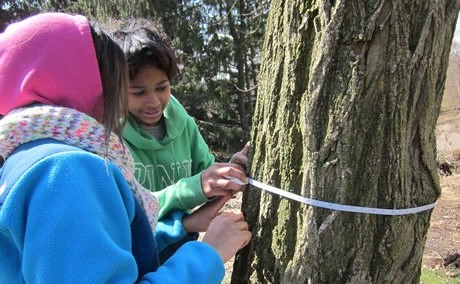
Partners in Education
Research partnership with Morris Arboretum reaches nearly 1,000 students in the first year
A new partnership among the Forest Service’s Northern Research Station, the Morris Arboretum of the University of Pennsylvania, and four Philadelphia-area schools is integrating more environmental science into every-day learning for 950 students and 35 educators, and empowering them to make positive changes, such as taking action to improve local water quality. Researchers and Arboretum staff are working with each school to create tailored, year-long programs addressing curricular needs. The individual programs range from monthly hikes on Arboretum grounds to discuss forestry and watershed issues, to an in-depth inventory and analysis (conducted by students) of the ecological benefits of trees on W.B. Saul High School’s 130-acre campus. This program has an added benefit of exposing youth to a variety of environmental careers through an Outdoor Career Symposium, panel discussions, and hands-on workshops. This partnership was funded through a Forest Service “More Kids in the Woods” grant.
- Contact:
- Products & Resources:
- Partners:
- Year: 2013
Northern Research Station 2013 Research Highlights
From the Station Director
Hello. My name is Michael Rains and I have the honor of serving as Director of two amazing programs within the U.S. Forest Service: the Northern Research Station and the Forest Products Lab. This presentation displays some of the very best science produced by the Northern Research Station in 2013.
The science we do revolves around forests and grasslands and, at its core, people. Whether you own woodlands or live in an urban high rise, our work makes a difference to your life. Our science helps ensure sustainable forests for clean air and water, resilient landscapes that can withstand the effects of a changing climate, and healthy urban forests.
Our work is contributing to better decisions about forests and grasslands, rural and urban alike.
Our accomplishments in 2013 include developing a novel approach to predicting water quality in the Great Lakes based on land use, which gives land managers a tool that is more affordable than water sampling and that allows communities to better target the use of scarce restoration funds. We made it possible to use forest inventory data to map the nation's forest carbon stocks. We developed techniques that engage landowners in enhancing the biodiversity of songbird and pollinator populations in backyards and urban forests.
Our research on urban forests is linking trees with human health and safety.
This year, our research examined the benefits of urban forests for human health and found that in 10 U.S. cities, trees remove enough fine particulate air pollution to save an average of one life per year. In New York City, trees are saving an average of eight lives a year. Our work In Ohio, where millions of trees have been killed by the invasive emerald ash borer, is making parks and preserves safer for people by giving land managers a tool for identifying dead trees that pose the greatest risk for visitors.
Our work is expanding knowledge of the effects of a changing climate and how landscapes might adapt to those changes.
Our research is contributing to reducing deforestation and promoting sustainable landscapes in the United States and Mexico. We discovered that trees are already using water more efficiently in response to rising carbon dioxide levels, which could result in greater timber yields as well as offset the effects of drought in the future. We established that people can aid in the process of tree migration with planting efforts. We found hopeful news in eastern forests – red spruce trees are rebounding after years of decline related to acid rain.
Doing the science is just part of our job. Whether it is in the form of technical reports, software, or web applications, Northern Research Station scientists’ work is accessible online. Virtually all the research papers we’ve produced, more than 11,000 of them, are available online.
I hope that you enjoy this presentation of our best work during the past year. Even more, I hope that you are inspired to visit our website or follow us on Twitter and learn more about what we’re doing to improve people’s lives and to make the nation’s forests healthier and more sustainable.
- Research Work Units: 14
- Research Locations: 25
- Experimental Forests: 24
- Employees: 377
- Web: www.nrs.fs.fed.us
- Twitter: @usfs_nrs
